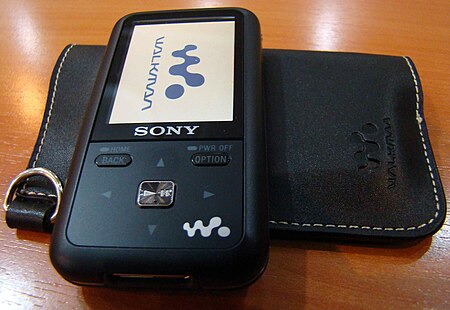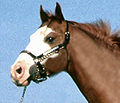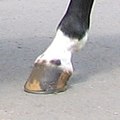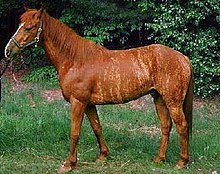Horse markings
|
Read other articles:

Ahmad DjuharaLahir(1966-11-22)22 November 1966Meninggal27 Maret 2020(2020-03-27) (umur 53)KebangsaanIndonesiaAlmamaterUniversitas Katolik Parahyangan (S.T.)PekerjaanKetua Ikatan Arsitek IndonesiaTahun aktif2015-2020Dikenal atasArsitekSuami/istriWendy Djuhara Ahmad Djuhara (22 November 1966 – 27 Maret 2020) adalah tokoh arsitek Indonesia yang menjabat sebagai ketua Ikatan Arsitek Indonesia periode tahun 2015-2018 dan periode 2018-2021. Sebelumnya, ia juga telah menjabat …

Rihanna holds the record for the most number ones and weeks at number one on the chart Kid Laroi and Justin Bieber spend the most weeks at number one with one track with Stay The ARIA Hip Hop/R&B Singles Chart, formerly the ARIA Urban Singles Chart, ranks the best performing hip hop and R&B tracks within Australia and is provided by the Australian Recording Industry Association. History The ARIA Hip Hop/R&B Singles Chart was established as the Urban Singles Chart in 2001 and first pu…

EssilorLuxottica Création 1er octobre 2018 Forme juridique Société anonyme Action Euronext : EL Siège social 147, rue de Paris94220 Charenton-le-Pont France Direction Francesco Milleri (Président et Directeur général)Paul du Saillant (Directeur général délégué) Actionnaires Delfin : 32 %Valoptec (association des salariés/retraités actionnaires) : 4,2% Activité Fabrication de lunettes (d)[1] Produits Verres correcteurs, montures optiques et lunettes de…
Prien am Chiemsee. Prien am Chiemsee adalah kota yang terletak di distrik Rosenheim di Bayern, Jerman. Kota Prien am Chiemsee memiliki luas sebesar 20.69 km². Prien am Chiemsee pada tahun 2006, memiliki penduduk sebanyak 10.050 jiwa. lbsKota dan kotamadya di Rosenheim Albaching Amerang Aschau im Chiemgau Babensham Bad Aibling Bad Endorf Bad Feilnbach Bernau am Chiemsee Brannenburg Breitbrunn am Chiemsee Bruckmühl Chiemsee Edling Eggstätt Eiselfing Feldkirchen-Westerham Flintsbach Frasdor…

هذه المقالة عن المجموعة العرقية الأتراك وليس عن من يحملون جنسية الجمهورية التركية أتراكTürkler (بالتركية) التعداد الكليالتعداد 70~83 مليون نسمةمناطق الوجود المميزةالبلد القائمة ... تركياألمانياسورياالعراقبلغارياالولايات المتحدةفرنساالمملكة المتحدةهولنداالنمساأسترالياب…

South Korean professional Overwatch player In this Korean name, the family name is Kwon. StrikerKwon in 2022Personal informationName권남주(Kwon Nam-joo)Born1999 or 2000 (age 23–24)[1]NationalitySouth KoreanCareer informationGameOverwatchPlaying career2017–presentRoleDamageTeam history2017ROX Orcas2018Boston Uprising2019–2021San Francisco Shock2022Boston Uprising2022San Francisco Shock2023Boston Uprising2023San Francisco Shock Career highlights and awards 2× OWL…

This article is about viaducts built by the Cornwall Railway Company (1859 to 1889). For viaducts built by other railway companies in Cornwall, see List of railway bridges and viaducts in the United Kingdom. Map all coordinates using OpenStreetMap Download coordinates as: KML GPX (all coordinates) GPX (primary coordinates) GPX (secondary coordinates) The 70 miles (110 km) of the Cornwall Railway included 42 wooden viaducts, such as Carvedras viaduct in Truro The Cornwall Railway company con…

烏克蘭總理Прем'єр-міністр України烏克蘭國徽現任杰尼斯·什米加尔自2020年3月4日任命者烏克蘭總統任期總統任命首任維托爾德·福金设立1991年11月后继职位無网站www.kmu.gov.ua/control/en/(英文) 乌克兰 乌克兰政府与政治系列条目 宪法 政府 总统 弗拉基米尔·泽连斯基 總統辦公室 国家安全与国防事务委员会 总统代表(英语:Representatives of the President of Ukraine) 总理…

روسيلنيوس (بالفرنسية: Roscelin de Compiègne) معلومات شخصية الميلاد 1050كومبيين الوفاة 1120بيزانسون مواطنة فرنسا الحياة العملية التلامذة المشهورون بيار أبيلار المهنة فيلسوف، وعالم عقيدة اللغات اللاتينية تعديل مصدري - تعديل روسلان (1050 - 1125) ، (بالإنجليزية: Roscellinus)�…

EindhovenMunisipalitas dan kotaCakrawala pusat kota BenderaLambang kebesaranNegara BelandaProvinsiBrabant UtaraArea COROPZuidoost-Noord-Brabant (Brabant Utara Tenggara)Pemerintahan • Wali kotaJeroen Dijsselbloem (PvdA)Luas(2006) • Munisipalitas dan kota88,84 km2 (3,430 sq mi) • Luas daratan87,75 km2 (3,388 sq mi) • Luas perairan1,09 km2 (42 sq mi)Populasi (1 Januari 2010) • Munisipa…

Rebellion during the French Revolutionary Wars Irish Rebellion of 1798Part of the Atlantic Revolutions and the French Revolutionary WarsBattle of Vinegar Hill by William Sadler Kelvin II (1880) Charge of the 5th Dragoon Guards on the insurgents – a recreant yeoman having deserted to them in uniform is being cut downDate24 May – 12 October 1798 (4 months and 18 days)LocationIrelandResult Suppression by Crown forces Abolition of the Irish Parliament and creation of the United Kingdom of Great …

Razan Zaitouneh BiografiKelahiran29 April 1977 (47 tahun)Suriah KegiatanSpesialisasiHukum, hak asasi manusia, Aktivisme, civic engagement, political activity dan jurnalisme Pekerjaanjurnalis, aktivis hak asasi manusia, pengacara, ahli hukum KeluargaPasangan nikahWael Hamada Penghargaan(2014) Petra-Kelly-Preis(2013) International Women of Courage Award(2012) Ibn Rushd Prize for Freedom of Thought(2011) Anna Politkovskaya Award(2011) Penghargaan Sakharov R…

Upland region vs. wetland vs. lacustrine zones Upland game bird is an American term which refers to non-waterfowl game birds in groundcover-rich terrestrial ecosystems above wetlands and riparian zones (i.e. uplands), which are commonly hunted with gun dogs (pointing breeds, flushing spaniels and retrievers).[1][2] United States See also: Upland hunting As of 2013 the population of upland game birds such as pheasants had been falling in agricultural states such as Iowa where incr…

Cet article est une ébauche concernant la musique. Vous pouvez partager vos connaissances en l’améliorant (comment ?) selon les recommandations des projets correspondants. Walkman Sony WM-GX302 (1995). Walkman NWZ-S618F (2008). Un baladeur est un appareil électronique portable de très petit format (de poche) destiné à l'écoute de musique. Certains modèles permettent l'enregistrement, ou sont munis d'un écran permettent la visualisation de contenus multimédias. Histoire Cette sec…

This article has multiple issues. Please help improve it or discuss these issues on the talk page. (Learn how and when to remove these template messages) This article needs additional citations for verification. Please help improve this article by adding citations to reliable sources. Unsourced material may be challenged and removed.Find sources: 1998 Maine gubernatorial election – news · newspapers · books · scholar · JSTOR (October 2019) (Learn how and …

For other places with the same name, see Greenville (disambiguation). Place in Sinoe County, LiberiaGreenville CityGreenville CityLocation in LiberiaCoordinates: 5°01′N 9°02′W / 5.017°N 9.033°W / 5.017; -9.033Country LiberiaCountySinoe CountyDistrictGreenville DistrictPopulation (2008) • Total16,434ClimateAf Greenville is the capital of Sinoe County in southeastern Liberia and lies on a lagoon near the Sinoe River and the Atlantic Ocean. It is loc…

Former French university existing from 1971 to 2018 This article is about the successor of the faculty of humanities of the University of Paris, active from 1971 to 2017. For its successor, see Sorbonne University. Paris-Sorbonne UniversityUniversité Paris-Sorbonne (Paris IV)TypePublicActive1 January 1971 (1971-01-01)–31 December 2017 (2017-12-31)Academic affiliationsSorbonne University groupBudget€118,800,000[1]PresidentBarthélémy JobertAcademic staf…

American college football season 1958 Illinois Fighting Illini footballConferenceBig Ten ConferenceRecord4–5 (4–3 Big Ten)Head coachRay Eliot (17th season)MVPGene CherneyCaptainJack DelveauxHome stadiumMemorial StadiumSeasons← 19571959 → 1958 Big Ten Conference football standings vte Conf Overall Team W L T W L T No. 2 Iowa $ 5 – 1 – 0 8 – 1 – 1 No. 7 Wisconsin 5 – 1 – 1 7 – 1 – 1 No. …

Tyne and Wear Metro station in Newcastle upon Tyne West JesmondTyne and Wear Metro stationGeneral informationLocationJesmond, Newcastle upon TyneEnglandCoordinates54°59′36″N 1°36′35″W / 54.9934350°N 1.6098034°W / 54.9934350; -1.6098034Grid referenceNZ250666Transit authorityTyne and Wear PTEPlatforms2Tracks2ConstructionBicycle facilities5 cycle podsAccessibleStep-free access to platformOther informationStation codeWJSFare zoneAHistoryOriginal companyNorth Easte…

2008年夏季奥林匹克运动会丹麦代表團丹麦国旗IOC編碼DENNOC丹麥國家奧林匹克委員會及體育同盟網站www.dif.dk(丹麦文)2008年夏季奥林匹克运动会(北京)2008年8月8日至8月24日運動員84參賽項目16个大项旗手Joachim Olsen獎牌榜排名第30 金牌 銀牌 銅牌 總計 2 2 3 7 历届奥林匹克运动会参赛记录(总结)夏季奥林匹克运动会189619001904190819121920192419281932193619481952195619601964196819721976198019841988…




















